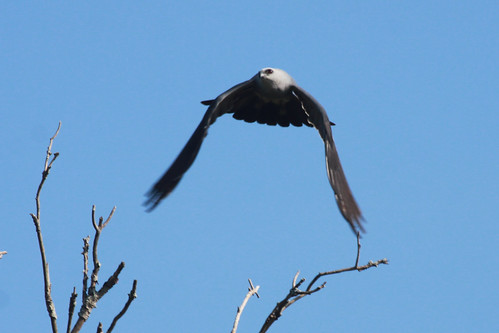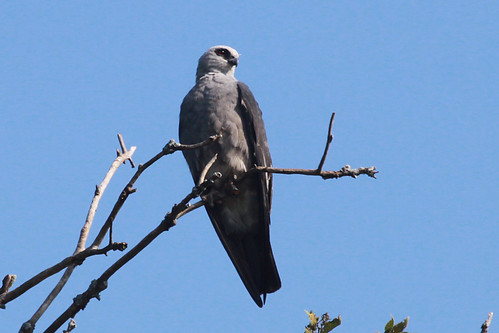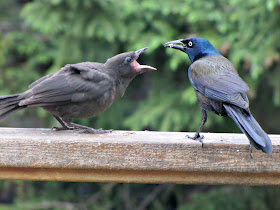Year after year my hometown of Rockford, Illinois has been the nesting site of a family of Mississippi Kites.
These birds are quite north of their "field guide" range but for the last several years they have reliably returned to the same location in northern Illinois.
A few days ago I visited the spot where I've seen them for the past four years (I think my first sighting was 2008).
After about 15 minutes of relaxing on a shaded bench I could hear a calling kite and a moment later, there was a beautiful adult bird gliding by. The bird floated effortlessly for five minutes or so and then continued out of sight.
Each year a nest has been found but is kept secret do to the influx of photographers and birders to the area which has the potential to disrupt the birds. After five years of seeing these beautiful birds, I am still in awe at their grace and beauty and joyous they hang out so close to where I work.
Learn more about Mississippi Kites from Cornell's All About Birds.
These photos were taken in August 2010 and are much better than I could have gotten this time around.
Posted by Eddie Callaway BirdFreak.com
▼
Saturday, June 30, 2012
Friday, June 29, 2012
Major League Bird Mysteries
Are you always birding? Even when you should be just enjoying some other activity?
Wednesday night I took my son to a Phillies game, and couldn't turn off the birds. There wasn't a whole lot of birds to see, mostly just Chimney Swifts darting around over Citizen's Bank Park at dusk. But there was one pigeon that seemed to want to get in on the game during the top of the first inning.
Since the Pirates didn't score during the first inning, but Utley and Ruiz back-to-back homered for the Phillies in the bottom of the 1st, I thought for sure this must be a lucky pigeon. But then it disappeared, and the Pirates ended up winning 11-7. So was this a lucky pigeon, that we needed to see more of during the rest of the game, or a bad Pirate pigeon coming to steal the game for the Phillies? I guess we need more data on this one, so perhaps folks who spend more time at Phillies or Pirates games can tell me more about the relationship between these teams and these birds?
For birders, here's another major league mystery--is the Phillies Phanatic actually a bird? Here he is doing the customary 7th inning dance on top of the Phillies dugout.
Wednesday night I took my son to a Phillies game, and couldn't turn off the birds. There wasn't a whole lot of birds to see, mostly just Chimney Swifts darting around over Citizen's Bank Park at dusk. But there was one pigeon that seemed to want to get in on the game during the top of the first inning.
 |
| What's that trying to steal home along the third base line? |
 |
| Major league pigeon |
For birders, here's another major league mystery--is the Phillies Phanatic actually a bird? Here he is doing the customary 7th inning dance on top of the Phillies dugout.
Notice the tail. Sure looks like feathers to me! So is the Phanatic really some sort of flightless tube-beaked bird? Can I add him to my eBird checklist for Wednesday night? Does he count on my ABA list? Perhaps we can get the eBird folks and the American Birding Association checklist committee to chime in on this one!
In the meantime, have fun out there, and bird responsibly!
Did he say Tremulous Tanager?
Guest post from Tim Avery of the Utah Birders blog and TimAveryBirding.com
So over time I have seen numerous posts talking about bird names and some of the historic names that were a better fit, or some of the current names that don't make sense, or names that just plain suck. I often wonder why specific nomenclature was used in the first place, or changes later on aside from a species split or lump. Even then names like Dark-eyed Junco for instance seem like an odd choice for a species that could be defined by numerous other characteristics, aside from that "dark eye". What about the Varied Junco or the Chattering Junco--I would even be partial to a new grouping, how about the Chattering or Varied Wanderer? Perhaps speaking to complex mixed breeding of the subspecies we call it the Promiscuous Junco? That might be my favorite for this species.
How about Rose-breasted and Black-headed Grosbeak--those are great descriptive names for the two birds, but in terms of interesting they seem rather plain. Gray Jay is one that really stings me--honestly something like Alpine Jay, or Tundra Jay is so much more fitting. But hey, the "color" gray is descriptive enough right? And it matches up to the Green, Brown, and Blue Jay--never mind the Scrub or Steller's Jay though, they were after all already blue.
Birds named after cardinal directions also leave me feeling uneasy. The Northern Flicker for instance is found far and wide east to west--not to mention across the entire south. What about the Northern Rough-winged Swallow--are we talking north of the Equator? Because the Southern Rough-winged Swallow and it's northern cousin meet in up Central America. Lest we forget the Eastern Towhee and the Western Grebe and the split across this great continent. Don't get me wrong I understand why some of these birds have the generalized descriptors used for their names--but it just seems like far too many have been done a disservice because of it.
Of course there is one bird above all others that bothers me--the Western Tanager. It's my favorite bird with a breathtaking pattern and color set. I can think of a couple name more apt--how about the Aspen Tanager (yes this species spends a great deal of time in Aspen as well as Conifers), or Tremulous Tanager (another take to Aspen, or Populus tremuloides its the scientific name).
I mean saying I saw 500 Tremulous Tanagers in a day sounds way more epic than saying I saw 500 Western Tanagers in a day. Just the name adds a bit of mystique and interest. I also wouldn't feign at names like Flammulated Tanager, Fire-faced Tanager, or the simple yet all encompassing Incredible Tanager. How many times have you heard a birder or non-birder alike say, "Wow that's Incredible!" upon seeing a Western Tanager?
So now that I've told you a couple bird names I would change, if you could change 1, 2, or a few bird names, what ones would you choose, and why? Comment below anonymously or using just your name, or a Google account, etc. I'm interested to see what others have to say!
So over time I have seen numerous posts talking about bird names and some of the historic names that were a better fit, or some of the current names that don't make sense, or names that just plain suck. I often wonder why specific nomenclature was used in the first place, or changes later on aside from a species split or lump. Even then names like Dark-eyed Junco for instance seem like an odd choice for a species that could be defined by numerous other characteristics, aside from that "dark eye". What about the Varied Junco or the Chattering Junco--I would even be partial to a new grouping, how about the Chattering or Varied Wanderer? Perhaps speaking to complex mixed breeding of the subspecies we call it the Promiscuous Junco? That might be my favorite for this species.
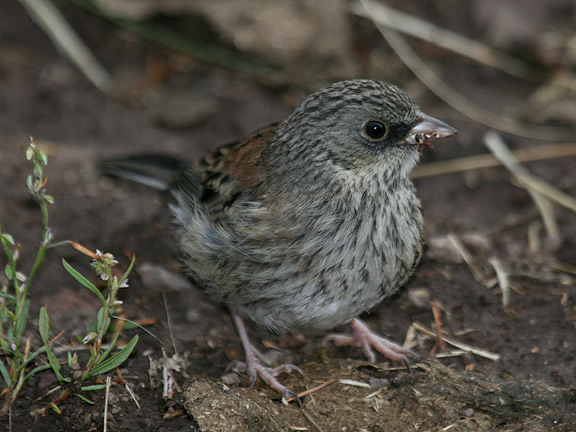 |
| Dark-eyed Junco or Promiscuous Junco? |
 |
| Gray Jay or Alpine Jay? |
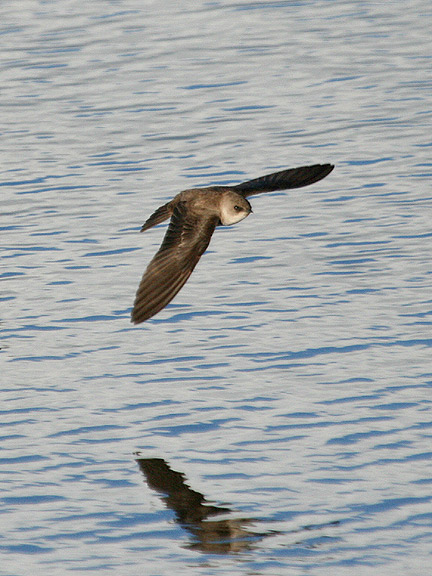 |
| Northern Rough-winged Swallow |
 |
| Western Tanager or Tremulous Tanager? |
So now that I've told you a couple bird names I would change, if you could change 1, 2, or a few bird names, what ones would you choose, and why? Comment below anonymously or using just your name, or a Google account, etc. I'm interested to see what others have to say!
Thursday, June 28, 2012
June Challenge
 |
| Brown-headed Nuthatch Econ River Wilderness Area |
 |
| Black-bellied Whistling Ducks Central Winds Park |
 |
| Limpkin Cameron Wight Park |
 |
| Eastern Bluebird Geneva Wilderness Area |
 |
| Pine Warbler Econ River Wilderness Area (I've never been so close to a Pine Warbler before) |
 |
| Eastern Towhee Econ River Wilderness Area |
- Once a Day. Decide for a period of time that you will do at least some birding every day, even if all you can do is 10 minutes in your back yard.
- Patch Birding. Choose a local patch and document the birds that you see there. I do this in my office parking lot, of all places. The parking lot is bordered by a lake and a recreational park, so it's been fun to get to work 30 minutes early just to see what's there.
- Habitats. Decide to visit only one habitat for a period of time; conversely, decide not to visit the same habitat twice during a period of time. I seem to spend most of my birding time near water--lakes, wetlands, marsh, etc. So lately I've been looking for dryer places, like pine forest, sand hill, and scrub habitats.
- Locations. Choose a county or other region to concentrate on. Or decide to avoid your favorite location for a while to see what you've been missing elsewhere.
 |
| Bachman's Sparrow Wekiwa Springs State Park |
Anyone have any other challenges worth trying? Please share your ideas below.
Scott Simmons
Wednesday, June 27, 2012
Random Scenes From A June Yard
From my yard in Alberta, Canada
Cast of characters in order of appearance: House Finch and Pine Siskins, Juvenile "Tufty" House Finches, American Goldfinches, White-crowned Sparrows, House Sparrow, Yellow Warbler, Mourning Dove, Cedar Waxwing, European Starling, American Robin, Downy Woodpecker, Juvenile Hairy Woodpecker, Northern Flicker, Common Grackles, Red-winged Blackbirds (and House Sparrow), Brown-headed Cowbirds.
And if you're wondering, the answer is 5 pounds of sunflower hearts per day, plus black oil & niger seed.
As a bonus shot, I just had to include this photo of this 'tummy-tanning' juvenile grackle. His feet are facing towards the left of the picture, his tail is on the right but his stomach is facing the sun. He sat there with his head thrown back and his beak open for over 3 minutes, then shook himself straight and did it again. And there were four of them doing this - have we had a lot of rain this month or what?!
Tuesday, June 26, 2012
BirdCaching!
I was introduced to geocaching about six years ago by a friend in Arizona. My kids loved the treasure hunting and exchanging of trinkets. Though I thought it was fun and interesting, I never really got into geocaching simply because I didn't have a GPS device. My brother, just 364 days younger than me, is an avid geocacher. My kids and I have enjoyed geocaching with him when he visits. Once I got a smartphone and had the ability to use geocaching apps, the door was again opened to me to participate in this fun activity. Since I live the mantra "always be birding", I found it very natural to combine the two activities of geocaching and birding.
Geocaching and birding have many characteristics in common. Both allow one to experience the thrill of the hunt in an intense or leisurely game of hide-and-seek. Participants try to get as many as possible, be it birds or caches. Both motivate you to get out and explore areas that you otherwise would not - bringing excitement and adventure. Both have about the same amount of nerdiness involved, including similar amounts of specialized equipment, apps, podcasts, and blogs. Geocaching forums can be just as snarky as birding listservs as folks layout their subjective opinions for the rules of the game. Most of all, geocaching and birding are similar in that we are finding things in plain sight that the average person on the street is missing out on.
In an effort to spread the joy of birding and to add another element of fun to birding may I introduce:
Birding + Geocaching = BirdCaching
 What you need to get started:
What you need to get started:
How to BirdCache:
*The Groundspeak Geocaching Logo is a registered trademark of Groundspeak, Inc. Used with permission.
Geocaching and birding have many characteristics in common. Both allow one to experience the thrill of the hunt in an intense or leisurely game of hide-and-seek. Participants try to get as many as possible, be it birds or caches. Both motivate you to get out and explore areas that you otherwise would not - bringing excitement and adventure. Both have about the same amount of nerdiness involved, including similar amounts of specialized equipment, apps, podcasts, and blogs. Geocaching forums can be just as snarky as birding listservs as folks layout their subjective opinions for the rules of the game. Most of all, geocaching and birding are similar in that we are finding things in plain sight that the average person on the street is missing out on.
In an effort to spread the joy of birding and to add another element of fun to birding may I introduce:
Birding + Geocaching = BirdCaching
 What you need to get started:
What you need to get started:- GPS device or GPS enabled smartphone
- Geocaching.com account (free or premium accounts available) - - You can add me as a friend on that site. My username is Birding is Fun!
- Geocaching app by Groundspeak* (recommended)
- BirdLog app (recommended)
Never heard of geocaching??? Check out this primer video clip.
- While visiting traditional geocache locations, simply conduct a stationary survey for 5 minutes or longer identifying all the birds you see and/or hear.
- Report sightings to eBird using the BirdLog app, or make a list to report later on eBird.org.
- You can also share your bird sightings list in your cache log on your geocaching app or when logging the find on Geocaching.com. Perhaps this will serve as an outreach program to interest more people in birding.
- Follow cache placing guidelines from Geocaching.com
- Register the cache location on Geocaching.com and name it "[location name] - BirdCache". Naming it like this will let other birders know that it was specifically placed as a BirdCache site. It will also let regular geocachers know beforehand what type of cache it is.
- If it does not already exist, create an eBird hotspot for this location so others can use it on eBird and so you can enjoy tracking the bird sightings data at that location.
- Consider creating a series of BirdCaches at great birding locations near you. (Always obtain permission from the land owner first!)
 |
| BirdCache using an ammo box |
- Log Book - an inexpensive notepad in a zip-lock sandwich bag to avoid moisture damage.
- Pencil/Pen for finders to write with.
- Instructions inviting cache finders to indicate the date and time and to list all the birds seen and/or heard from the cache location. May include an invitation to use eBird, a free service for logging bird sightings. Please indicate that the birding aspect of this cache is completely optional for the finder.
- Include a laminated pamphlet of birds of the area, a checklist of area birds, or maybe even a field guide.
- Invite non-birder cache finders to download a birding app to their smartphones. They are so inexpensive now they're almost free!
- Depending on the size of the cache, you may include other trinkets for trade.
- Trackable items are also fun. Send one out into the world and see where it goes. Perhaps include instructions asking it to show up at a birding festival you plan to attend.
I will monitor BirdCaches listed on Geocaching.com and maintain a list of them on a BirdCaching dedicated page on this website. When you go BirdCaching or place a BirdCache, please tell us about it!
*The Groundspeak Geocaching Logo is a registered trademark of Groundspeak, Inc. Used with permission.
Monday, June 25, 2012
Review: The Kirtland's Warbler
I just finished reading "The Kirtland's Warbler: The Story of a Bird's Fight Against Extinction and the People Who Saved It" by William Rapai and published by The University of Michigan Press. Normally I don't choose to read books like this because I fear that they will be depressing. I confess that when it comes to certain environmental concerns, I just want to plug my ears, close my eyes, and hope it goes away. I don't think I'm alone in feeling like this, though that train of thought is dangerous. Anyway, Rapai's writing is not depressing at all. The writing was fantastic! A page-turner for a historical narrative. Without shying away from the ugly side of conservation and the controversial issues, this book conveyed a lot of hope for the future of the Kirtland's Warbler. Rapai identifies late and modern day heroes. The history of the Kirtland's Warbler and all the characters around it are simply fascinating. This book is definitely worth the read.
I've been a long-time fan of the Brown-headed Cowbird and even wrote a sonnet in their honor. I wondered why so many birders hated them so much. Now, knowing the historical context of the cowbird versus the Kirtland's Warbler, my opinion has been swayed. I can't wait to see my first Kirtland's Warbler and I thank everyone mentioned in the book for their efforts in preserving this unique and awesome species.
This book is listed for $24.95 and is currently available online for $16.73.
The University of Michigan Press provided me a review copy of this book.
I've been a long-time fan of the Brown-headed Cowbird and even wrote a sonnet in their honor. I wondered why so many birders hated them so much. Now, knowing the historical context of the cowbird versus the Kirtland's Warbler, my opinion has been swayed. I can't wait to see my first Kirtland's Warbler and I thank everyone mentioned in the book for their efforts in preserving this unique and awesome species.
This book is listed for $24.95 and is currently available online for $16.73.
The University of Michigan Press provided me a review copy of this book.
Bay-breasted Warblers at Magee Marsh...
I always look forward to seeing Bay-breasted Warblers as they migrate through our area (Cincinnati, Ohio) in May. Their beautiful chestnut-colored flanks and black mask are striking, and they are not quite as hyper as other warblers as they move through the branches gleaning insects, so I usually get wonderful views of them. Problem is they are few and far between around my house, so when I headed up to Magee Marsh this May for The Biggest Week in American Birding warbler festival, I had my fingers crossed that a few would head my way (and did they ever, along with almost every other warbler possible!)...
Yesterday while trying to decided what kind of post to put together for Birding is Fun, I got my sketchbook out from the trip to see what kind of sketches I had drawn of Bay-breasted Warblers. I thought if I found a few sketches I liked, I'd paint a few paintings...

...if you have a chance next year to attend The Biggest Week in American Birding, don't hesitate! You will be amazed at all the warblers you'll see!
Happy Birding!
Kelly
 |
| Bay-breasted Warbler along the boardwalk at Magee Marsh during "The Biggest Week in American Birding" warbler festival. |
 |
| ...sketchbook entries from the Biggest Week in American Birding (Magee Marsh in Toledo, Ohio). |

I liked a few of the sketches, so I grabbed my watercolors and headed outside on the deck to paint. It was gorgeous outside--warm but not too hot, and a pair of Cedar Waxwings were overhead in the mulberry trees trilling and buzzing and chirruping in their special way. Listening to the birds while painting was nice. I even heard a Bobwhite (which is incredibly rare for our neighborhood. I haven't heard one since 1992!! The Bobwhite called out his name six separate times before moving on). In all, I did three quick watercolors of a Bay-breasted Warbler...
...if you have a chance next year to attend The Biggest Week in American Birding, don't hesitate! You will be amazed at all the warblers you'll see!
Happy Birding!
Kelly
Sunday, June 24, 2012
There's No Place Like Home
Before we get to the main part of my first post here on "Birding is Fun!", I wanted to take a minute to thank Robert Mortensen for honoring me with an invitation to become a regular contributor. I have been a reader of this blog and the individual blogs of several of the BiF contributors for some time. I really look forward to getting to know our readers over the coming months and years so please don’t be strangers!
A common misconception shared by many amateur avian watchers and photographers is the need to venture deep into isolation in order to photograph interesting species. I am often asked, “How far into the wilderness did you have to go to make that photograph”. This mindset often stops would be beginners from taking the plunge and becoming part of the birding revolution. The truth of the matter is you can enjoy bird watching from many places easily accessible to everyone. In fact, most successful photographers search out such locations. If you think about this, it makes perfect sense. The logistics and physical effort of carrying heavy gear on long hikes is not practical even for the rugged wildlife photographer! My own experience with hiking to remote photographic locations usually results in landscape photography, which requires a significantly smaller and lighter kit than wildlife photography.
I’ll share a secret with you. One of the best locations I photograph birds is my own backyard. Yes, you heard me right, my own backyard. It takes a little planning to ensure you are able to control the elements like background, light and perch size but the results are usually worth the effort. In fact, you need to control these elements regardless of whether you are in the wilderness or at the end of a fishing pier. Some of my favorite places to photograph are all public areas. Beaches as well as state and national parks are fantastic places to start looking for easily accessible wildlife.
The two images above and the Northern Flicker below were taken in my backyard. I know what some of you are saying, that I must live on a farm. The truth of the matter is I live in a suburb of New York City, in Fairfield County, Connecticut. While I might have a little more land than most, I don’t live on a bird sanctuary. But I do work hard to create an environment on my property that encourages bird visits. I always have full bird feeders and I provide water sources for the birds to drink. While some will say that’s a great idea, it really is not any different from how bird reserves operate in the southwest. They tend to
set up bird blinds around food and water sources and in some instances provides branches as perches away from where any trees are located. Even if photographing in your yard is not
practical, I promise you with a little effort and imagination you can find locations within your town and state where wildlife thrives not far from your local coffee shop.
The Internet is a great place to start your research. Local bird and wildlife organizations are a great resource when looking for places to photograph. Your local Audubon Society can usually make several suggestions if you call them and ask for help.
Lastly, local and national parks and wildlife refuges are scattered across many areas. Most people are shocked to find out just how many wildlife viewing locations there are in their community! Another fantastic resource is the Birding is Fun website and the websites of the many regular contributors. Many of us bird regularly and are not shy about giving away locations where you can safely and successfully view birds.
Once you select your locations, I promise you will be amazed at how many different species of wildlife you will encounter in your community. You will ask yourself how it is that you missed seeing the wildlife around you for so many years! Connecticut alone is filled with a healthy
wildlife community. Many people associate Connecticut with the mansions of Greenwich but the opportunity to learn from and about its wildlife is enormous. Connecticut is home to hundreds of bird species. Over 400 bird species have been identified in Connecticut.
So if you are reading this post and you have been thinking about becoming a birder or avian photographer but have been afraid to start because you think you need to travel to exotic locations, I am here to tell you that viewing wildlife doesn’t need to occur only in the wild. Don’t be afraid, start in your yard!
My Website: www.vincentmistretta.com
My Blog: www.vincentmistretta.com/blog
A common misconception shared by many amateur avian watchers and photographers is the need to venture deep into isolation in order to photograph interesting species. I am often asked, “How far into the wilderness did you have to go to make that photograph”. This mindset often stops would be beginners from taking the plunge and becoming part of the birding revolution. The truth of the matter is you can enjoy bird watching from many places easily accessible to everyone. In fact, most successful photographers search out such locations. If you think about this, it makes perfect sense. The logistics and physical effort of carrying heavy gear on long hikes is not practical even for the rugged wildlife photographer! My own experience with hiking to remote photographic locations usually results in landscape photography, which requires a significantly smaller and lighter kit than wildlife photography.
 |
| White Breasted Nuthatch Surveying the Landscape |
 |
| Tufted Titmouse with Seed |
The Internet is a great place to start your research. Local bird and wildlife organizations are a great resource when looking for places to photograph. Your local Audubon Society can usually make several suggestions if you call them and ask for help.
 |
| Mature Osprey Returning to the Nest |
 |
| Laughing Gull |
 |
| Northern Flicker |
My Website: www.vincentmistretta.com
My Blog: www.vincentmistretta.com/blog

